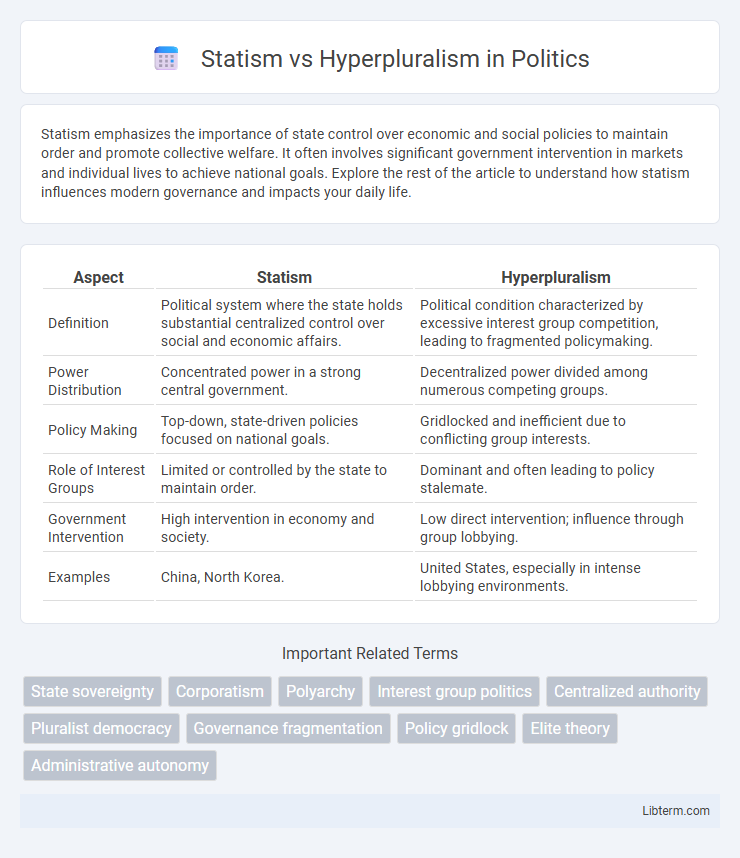Statism emphasizes the importance of state control over economic and social policies to maintain order and promote collective welfare. It often involves significant government intervention in markets and individual lives to achieve national goals. Explore the rest of the article to understand how statism influences modern governance and impacts your daily life.
Table of Comparison
| Aspect | Statism | Hyperpluralism |
|---|---|---|
| Definition | Political system where the state holds substantial centralized control over social and economic affairs. | Political condition characterized by excessive interest group competition, leading to fragmented policymaking. |
| Power Distribution | Concentrated power in a strong central government. | Decentralized power divided among numerous competing groups. |
| Policy Making | Top-down, state-driven policies focused on national goals. | Gridlocked and inefficient due to conflicting group interests. |
| Role of Interest Groups | Limited or controlled by the state to maintain order. | Dominant and often leading to policy stalemate. |
| Government Intervention | High intervention in economy and society. | Low direct intervention; influence through group lobbying. |
| Examples | China, North Korea. | United States, especially in intense lobbying environments. |
Understanding Statism: Core Principles and Ideologies
Statism emphasizes the central role of the state in organizing society, advocating for strong government authority to maintain order, enforce laws, and provide public goods. Core principles of statism include centralized control, regulation of economic and social activities, and the belief that state intervention is essential for economic development and social justice. Ideologies within statism range from authoritarian regimes to welfare states, unified by the conviction that a robust state apparatus is necessary to achieve collective goals.
Defining Hyperpluralism: Features and Implications
Hyperpluralism is characterized by an excessive fragmentation of political power, where numerous interest groups and factions compete to the point of gridlock, undermining effective governance. Unlike statism, which emphasizes centralized state control and authority, hyperpluralism highlights the challenges posed by intense competition among diverse groups that can lead to policy paralysis and weakened state capacity. This phenomenon results in a diffusion of power that complicates consensus-building and often stalls legislative processes, impacting the overall stability and functionality of political institutions.
Historical Evolution: Statism and Hyperpluralism
Statism evolved from centralized power structures of early modern nation-states emphasizing state sovereignty and authority in governance. Hyperpluralism emerged in the late 20th century as a reaction to the increasing complexity and diversity of interest groups influencing democratic systems, often leading to fragmented policymaking. Historical evolution shows statism prioritizing state control, whereas hyperpluralism highlights the challenges of managing multiple competing interests within political frameworks.
Key Differences Between Statism and Hyperpluralism
Statism emphasizes centralized government control and authority, whereas hyperpluralism highlights the excessive influence of diverse interest groups leading to governmental fragmentation. Statism advocates for state dominance in policy-making to maintain order and unity, while hyperpluralism describes a scenario where conflicting interests cause political gridlock and inefficiency. The key difference lies in statism's focus on power concentration versus hyperpluralism's emphasis on power diffusion and competition among multiple actors.
Impact on Political Institutions and Governance
Statism centralizes authority within political institutions, often leading to streamlined decision-making and stronger government control over policy implementation. Hyperpluralism, characterized by fragmented interest groups and competing demands, frequently results in legislative gridlock and weakened governance due to constant negotiation and compromise. The tension between these models influences the balance of power, with statism promoting institutional coherence and hyperpluralism encouraging diverse representation but complicating effective governance.
Policy Outcomes: Centralization vs Fragmentation
Statism promotes centralized policymaking where government institutions hold significant authority to ensure cohesive and uniform policy outcomes across regions. Hyperpluralism leads to policy fragmentation as multiple interest groups exert competing pressures, resulting in diluted or conflicting policies that hinder effective governance. Centralization under Statism aims for streamlined decision-making, whereas fragmentation under Hyperpluralism often causes legislative gridlock and inconsistent implementation.
Citizen Participation: Representation in Both Systems
Statism centralizes citizen participation through state-controlled representation, often limiting pluralistic voices in favor of unified national interests. Hyperpluralism, conversely, amplifies diverse group participation, resulting in fragmented representation that can impede cohesive policy-making. Both systems present distinct challenges for effective citizen engagement and balanced political representation.
Challenges of Statism in Diverse Societies
Statism in diverse societies faces challenges including the risk of authoritarianism and the suppression of minority group rights, which can lead to social fragmentation and unrest. Centralized control often struggles to accommodate the varied interests and identities within pluralistic populations, resulting in political alienation and reduced civic engagement. These challenges highlight the difficulty of maintaining state authority while ensuring inclusive representation and respect for cultural diversity.
Risks and Pitfalls of Hyperpluralism
Hyperpluralism poses significant risks to effective governance by fragmenting political decision-making and creating policy gridlock, as competing interest groups wield disproportionate influence that hampers consensus. This excessive pluralism often leads to inconsistent policies, weakened government authority, and challenges in addressing collective social needs due to the overrepresentation of niche interests. The pitfalls of hyperpluralism include the erosion of democratic responsiveness and an increased likelihood of legislative stalemate, undermining the state's capacity to implement coherent strategies.
Future Trends: Balancing Authority and Plural Interests
Future trends in statism and hyperpluralism emphasize nuanced governance models that balance centralized authority with diverse societal interests. Emerging political frameworks advocate adaptive regulatory mechanisms to mediate between state control and multifaceted group demands. Innovations in digital participatory platforms and decentralized policy-making are shaping the trajectory toward more inclusive yet coherent governance structures.
Statism Infographic

 libterm.com
libterm.com